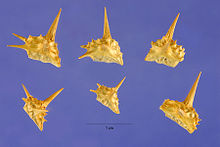Root thorns
| Root thorns | ||||||||||||
|---|---|---|---|---|---|---|---|---|---|---|---|---|

Trumpet thorn ( Tribulus terrestris ) |
||||||||||||
| Systematics | ||||||||||||
|
||||||||||||
| Scientific name | ||||||||||||
| Tribulus | ||||||||||||
| L. |
The plant genus Burzeldorne ( Tribulus ) belongs to the family of the zygophyllaceae (Zygophyllaceae). The best-known species is the earth-root thorn ( Tribulus terrestris ).
Description and synecology


Appearance and leaves
Tribulus species are annual , biennial to perennial herbaceous plants that are more or less prostrate. Above-ground parts of the plant are often hairy downy.
The constantly against arranged leaves are pinnate having three to twelve pairs pinna leaflet . Stipules are present.
Inflorescences and flowers
The stalked flowers are usually single in the leaf axils, sometimes in zymous inflorescences . The hermaphroditic flowers are radial symmetry and four to five-fold with a double flower envelope (perianth). The four or five free sepals are ovate. The four or five free petals are usually yellow. There are two circles with four or five stamens each; they are free from one another and also not grown together with the petals, those of the inner circle are clearly shorter; often five of them are sterile . There is a ring-shaped, fleshy, ten-lobed discus. Most five (rarely two to four) carpels have become a top permanent, oval to spherical ovary grown, which is divided by a false septum into several chambers - that distinguishes the genre from all the other family. Each ovary chamber usually contains two to five, rarely up to ten hanging ovules in axillary placentation . The stylus ends in a simple or five-lobed scar. Pollination is mostly done by insects ( entomophilia ).
fruit
They form split fruits , which usually have hard spines, so that the fruits get stuck on the feet and fur of animals and thus ensure an epizoochore spread.
distribution
The paleotropic genus Tribulus is widespread in tropical and subtropical countries in Asia, Africa, southern Europe, and northern Australia. It mainly thrives in arid and semi-arid areas. Most of the species are in the Saharo-Sindian phytogeographic zone . At least one species was introduced into the Neotropic as an invasive plant .
Systematics
The genus name Tribulus was Linnaeus in Species Plantarum 1, 1753, pp 386-387 published first . As lectotype was Tribulus terrestris L. in Vail and Rydberg: North American Flora , 25, set in 1910 S. 109th The generic name Tribulus refers to the same Latin word for the war weapon, crow's foot, made up of four nails or spikes. The genus Tribulus belongs to the subfamily Tribuloideae within the family of zygophyllaceae .
The genus Tribulus belongs to the subfamily Tribuloideae within the family Zygophyllaceae . Sometimes she was also placed in a family Tribulaceae.
There are around 15 to 20 humpback species ( Tribulus ) (selection):
- Tribulus cistoides L. (Syn .: Tribulus lanuginosus Blanco ): It occurs in Africa, Madagascar, the Comoros , Indonesia, Papua New Guinea , Australia and China.
- Tribulus longipetalus Viv.
- Tribulus macropterus Boiss.
- Tribulus micrococcus Domin : It occurs in Queensland and New South Wales .
- Tribulus ochroleucus (Maire) Ozenda & Quézel
- Tribulus parvispinus Presl
- Tribulus pentandrus Forssk. (Syn .: Tribulus alatus Delile ): It occurs in eastern and northern Africa, on the Arabian Peninsula, in western Asia and in Pakistan and India.
- Tribulus subramanyamii P.Singh, Giri & V.Singh
- Burrowthorn ( Tribulus terrestris L. , Syn .: Tribulus rajasthanensis Bhandari & VS Sharma , Tribulus lanuginosus L. , Tribulus bicornutus Fisch. & Mey. , Tribulus robustus Boiss. & Noé , Tribulus orientalis Kerner )
- Tribulus taiwanense T.C. Huang & THHsieh
- Tribulus zeyheri Sond.
swell
- Tribulus in the Western Australian flora . (Section description)
- Yingxin Liu & Lihua Zhou: Zygophyllaceae : Tribulus , p. 49 - the same text online as the printed work , In: Wu Zheng-yi & Peter H. Raven, Deyuan Hong (eds.): Flora of China , Volume 11 - Oxalidaceae through Aceraceae , Science Press and Missouri Botanical Garden Press, Beijing and St. Louis, 2008. ISBN 978-1-930723-73-3 (Description section)
- Yingxin Liu & Lihua Zhou: Zygophyllaceae in the Flora of Pakistan : Tribulus - Online. (Section description)
- M. Varghese, SS Yadav & J. Thomas: Taxonomic Status of Some of the Tribulus Species in the Indian Subcontinent , In: Saudi Journal of Biological Sciences , Volume 13, Number 1, 2006, pp. 7-12. ISSN 1319-562X : PDF-Online. (Section Description and Distribution)
Individual evidence
- ↑ Carl von Linné: Species Plantarum 1, 1753, pp. 386-387 scanned in at biodiversitylibrary.org .
- ^ Tribulus at Tropicos.org. Missouri Botanical Garden, St. Louis
- ^ A b c d Tribulus in the Germplasm Resources Information Network (GRIN), USDA , ARS , National Genetic Resources Program. National Germplasm Resources Laboratory, Beltsville, Maryland.
- ↑ Yingxin Liu and Zhou Lihua: zygophyllaceae. In: Flora of China, vol. 11, Zygophyllaceae. Tribulus

